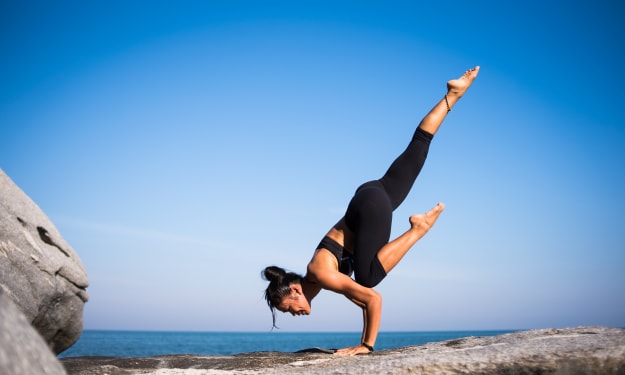16 of the greatest fitness advice ever given by renowned trainers
Whether you're new to fitness or want to improve, there are steps you can take.

Below, the experts provide their advice on how to enhance your routine and fitness journey, from properly warming up to pre-workout vitamins.
1. Begin modestly
You should create a workout routine that you can maintain and ultimately expand upon, advises Power In Movement creator and certified functional strength coach Kehinde Anjorin. When beginning your fitness adventure, Anjorin advises that you take a close look at your lifestyle and try not to overextend yourself—even if it means beginning with a once-per-week workout or committing to 10 minutes of exercise twice a week.
2. Develop a healthy lifestyle.
In a similar vein, NCSF-certified personal trainer Elise Young asserts that "the fitness journey is all about developing consistency and finding a method to make activity fit into your lifestyle." She advises beginning gradually and building on your foundation each day, much like Anjorin. She continues, and do a self-inventory in the morning, asking yourself what you can commit to for the day—a walk? A run? A lift? Make it a habit to move and meet yourself where you are right now, advises Young.
3. You should always warm up.
No exclusions, adds Taylor Rae Almonte, a personal trainer with NASM certification who is also an actress and an activist, "Warm up before every exercise." Injury may be avoided by doing this. Almonte's favorite exercises to do during a warm-up are plank walkouts, cat cows, and lateral lunges.
4. Make the warm-ups lively.
According to physical therapist Christina Ciccione, CSCS, who previously spoke with Women's Health, Almonte adds that static stretching shouldn't be done before to working out since it deters from explosive muscular performance and weakens muscles. The stretches mentioned above, as well as t-spine rotations and forward fold to squat, are all dynamic stretches, according to Almonte.
5. Don't completely stop static stretching
Stretching that is static is OK after exercise. In fact, the Cleveland Clinic claims that it may aid in preventing muscular stiffness. Almonte recommends that you hold each stretch for at least 30 seconds and no more than one minute.
6. Include mobility drills in your warm-up as well.
Mobility exercises shouldn't be done separately from your strength and conditioning exercises, according to personal trainer and coach Kristina Centenario. If you warm up your joints by going through their complete ranges of motion and managing that range, it may greatly benefit your exercises. She then proposes combining that dynamic movement with a little mild plyometric exercise, like jump training.
7. Work out your muscles at least twice a week.
Young asserts that the answer is strength training. After all, there are several advantages to this kind of training. Strength exercise, according to her, keeps us feeling powerful and strong. She continues by saying that it strengthens your bones, lowers your chance of injury, and enhances cardiovascular health.
8. Step up your strength training using an aerobic stepper.
The 1980s classic is excellent for workouts like Bulgarian split squats that call for an elevated surface, according to Women's Health. Additionally, you may use it to intensify exercises like lunges, pushups, and planks. Plus, according to NASM-certified trainer Stephanie Reyes, it may be a wonderful bench for workouts like chest presses and rows.
9. Maintain a varied cardio routine
There are several activities that may get your heart rate up without using a treadmill (or an elliptical, for that matter). For instance, Anjorin recently wrote for Women's Health that you may do an HIIT workout or circuit that includes movements like high knees and butt kicks. Jumping rope and kettlebell swings are two more excellent aerobic activities.
10. Properly combine strength training and aerobics
Your objectives will determine the best method to use. Basically, the sequence in which you do cardio and strength training should be determined by your priorities. For instance, you should start with cardio if you want to increase your endurance rather than strength training if you want to grow stronger.
11. Continue to push yourself.
The body changes, claims Anjorin. She advises continuing to advance in your strength training program in order to make your physique alter. For instance, if you're doing three sets of eight to ten repetitions of a certain exercise one week, you may advance to four sets of twelve the next week. Basically, keep working hard—whether you decide to use more weight or do more sets and repetitions.
12. Give form priority
According to NASM-certified personal trainer Angela Gargano, more isn't necessarily better. Better always wins. In other words, perfect your form while doing simple exercises before adding weight or making the activities more difficult.
13. Commit to your rehabilitation.
The advice from Centenari is to "commit to your rehabilitation as strongly as you would commit to training." According to Gargano, your muscles need it to recover and get stronger.
14. Uphold proper (sleep) hygiene
According to Anjorin, this aspect of fitness is underappreciated. Sleep is important for muscle repair and for giving you the energy you need to push yourself during exercises. She takes a hot shower, dry brushes, and sets her thermostat to roughly 18 degrees in the evening to relax (which is right in the ideal temp range for sleeping, according to the National Sleep Foundation). And I don't use screens just before night, she adds.
15. Establish a routine for your sleep
Young concurs that it's crucial to develop healthy sleep patterns and advises attempting to go to bed at around the same time each day since sleep is essential for recuperation. To enhance your sleep health, it's also crucial to continue getting up at the same time every day—even on weekends.
16. Focus on active rest days
The good news is that you don't have to on days when you don't feel like doing anything particularly strenuous, explains Centenari. Our bodies should move every day, but they don't have to dig into the earth constantly, she claims. However, missing that challenging HIIT session doesn't mean you should watch Netflix nonstop in its instead. Just listen to your body when it tells you to calm down, advises Centenari, and find a happy medium by taking a stroll, doing the laundry you've been putting off, or baking banana bread. "Keep things simple; go forward."
About the Creator
Enjoyed the story? Support the Creator.
Subscribe for free to receive all their stories in your feed. You could also pledge your support or give them a one-off tip, letting them know you appreciate their work.






Comments
There are no comments for this story
Be the first to respond and start the conversation.